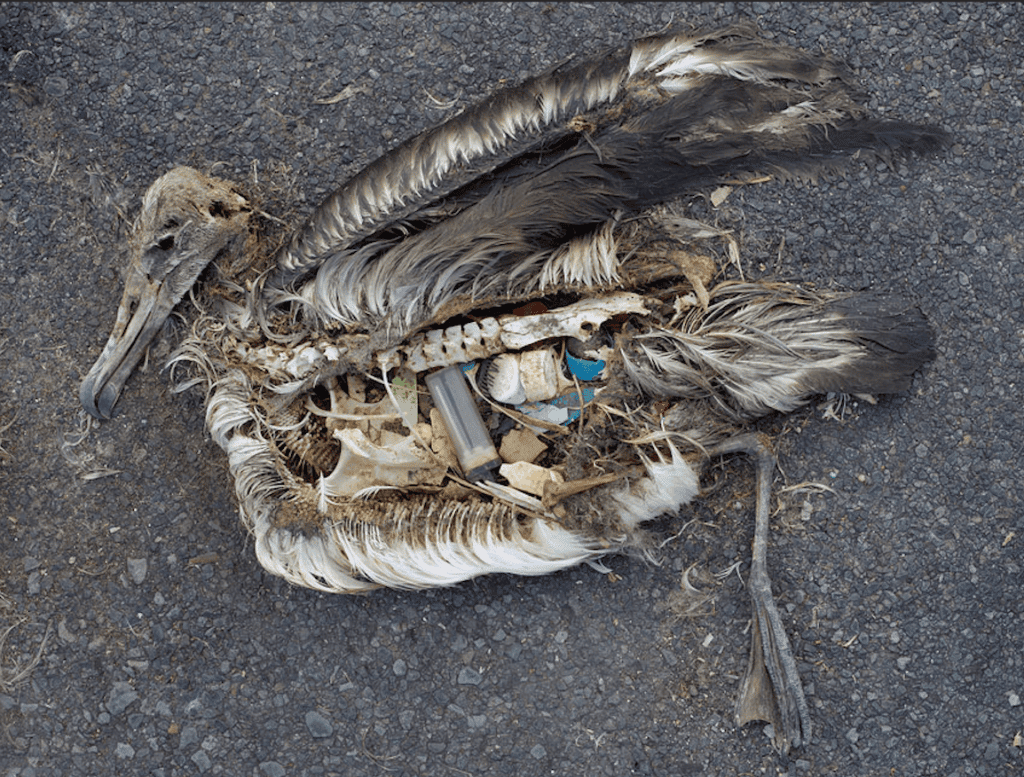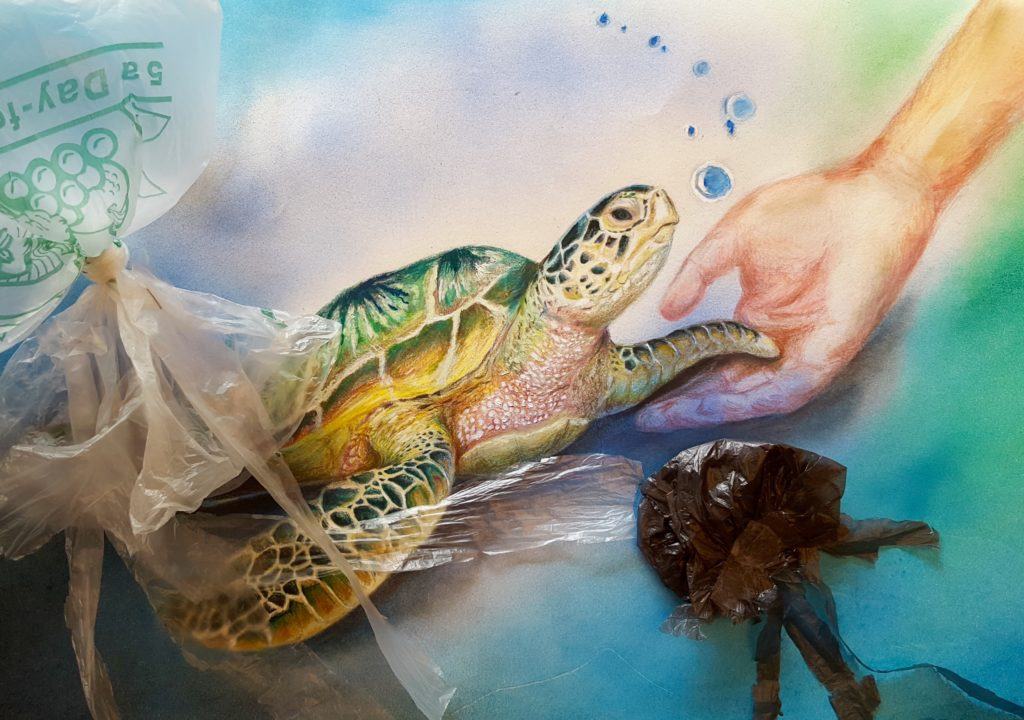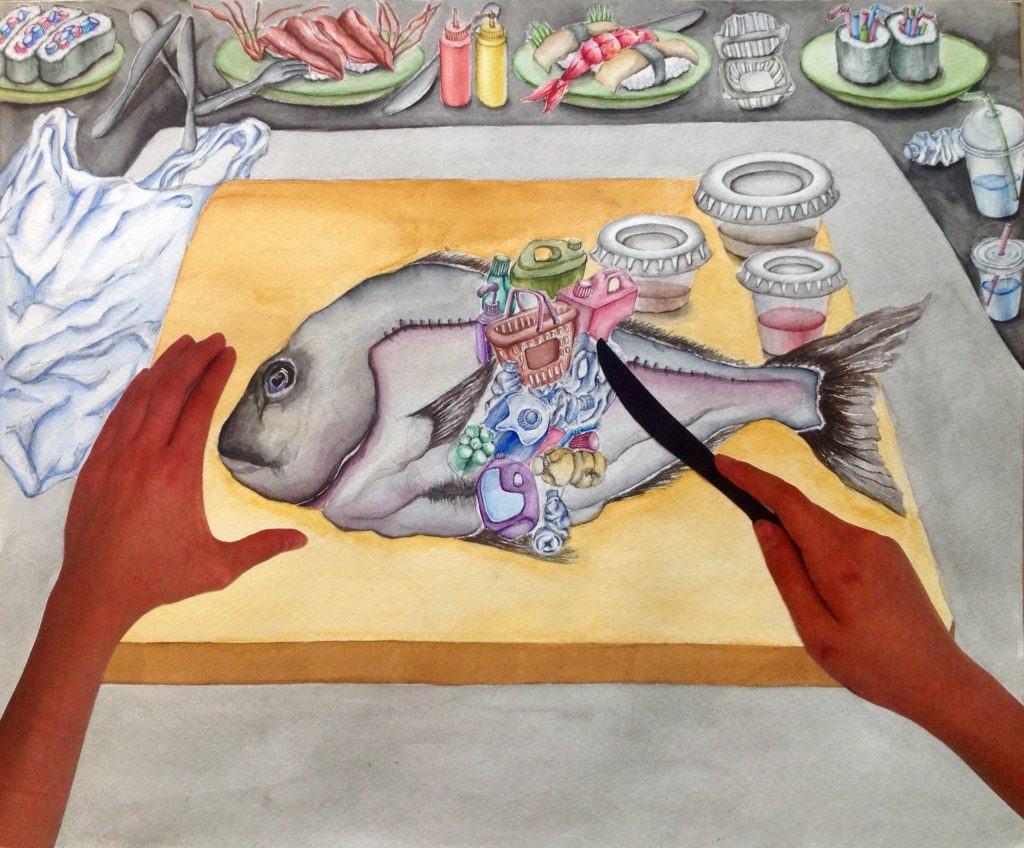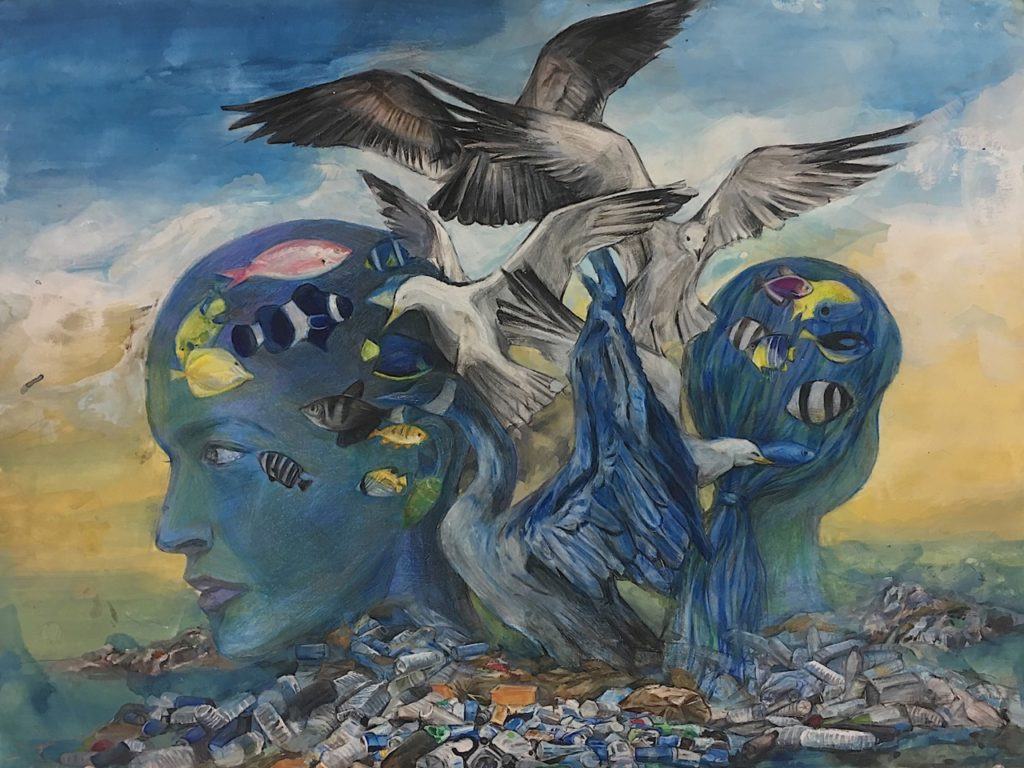
Marine Plastic Pollution & How to Reduce it
May 25, 2022By Kamakshi, Future Blue Youth Council Member
Featured artwork: “Untitled” Oksana Muzychenko, Ukraine
Warning: Some of the images in this blog are graphic, depicting animals entangled and killed by plastic pollution.
“I fought for my life. In the last seconds of it, all I could imagine was how I desperately wanted to live, but the jellyfish somehow wouldn’t go down my throat. And like the others, I struggled and died, too.”A dead turtle, if only it could speak
The Marine Plastic Pollution Problem
Today, scientists estimate that there are 5.25 trillion pieces of plastic debris in the oceans, of which 269,000 tons float on the surface. Trillions of these garbage pieces are dumped in the oceans by humans–ready to destroy the habitat of millions of marine animals. Sea turtles were amongst the first animals recorded to consume plastic debris.
Plastic pollution is a global concern, and it requires our immediate attention. Due to factors such as solar UV radiation, wind, and currents, the plastic that floats on the surface breaks down into small particles called micro- or nanoplastics. Their small size makes it easy for marine animals to ingest them.
The ingestion of plastic waste, which is often mistaken for food by marine wildlife, cannot only cause suffocation, but also immediate death, or death due to starvation as their stomachs fill with plastic. They also suffer from lacerations, infections, reduced ability to swim, and internal injuries. Floating plastic, therefore, threatens marine biodiversity and the food web.

A dead albatross chick on Midway Atoll National Wildlife Refuge in the Pacific in September 2009. Photo by Chris Jordan.
Ingested hooks or plastic can perforate the esophagus, resulting in organ damage and starvation, even with no visible external signs of entanglement. Seals are attracted to such floating debris and poke their heads into the loops and holes of nets, which can strangle them.
Why should I care anyway?
Glad you asked. If environmental degradation and marine life destruction are not good enough reasons to take action, then the fact that plastic pollution affects humans in adverse ways should be.
The toxins present in plastic are ingested by animals in the ocean. Toxins like lead, cadmium, and mercury have been found in several fishes in the ocean. We, in turn, ingest contaminated fish and mammals. Diethylhexyl phthalate (DEHP), present in some plastics, is a toxic carcinogen. Other toxins in plastic have been found to weaken the immune system, and cause cancers, birth defects, and childhood developmental issues.
Piles of plastic create an insulation layer that raises the surface temperature of seas and oceans. The increased temperature makes formerly unsuitable conditions habitable for algae. Industrial waste, agricultural runoff, pesticides, and human sewage can also spur algae growth. Excessive algal growth is detrimental as it leads to the production of harmful algal blooms (HABs). People are exposed to the HAB toxins by eating contaminated fish and shellfish, which are known to cause dementia, amnesia, neurological damage, and death.
Furthermore, since plastic traps the sun’s heat, it should come as no surprise that plastic pollution also contributes to global warming. What worsens the situation is the fact that plastic is extremely durable. Dr. Anthony Andrady notes that “except for a small amount that’s been incinerated, every bit of plastic manufactured in the world for the last 50 years or so still remains. It’s somewhere in the environment.” Thus, underestimation and ignorance of this problem by humans will only serve to be the cause of their own downfall in the future.
So now that you’re convinced that you need to do something, what can you really do?
- Participate in cleanup drives – Volunteering for such activities is a great way to show care for the planet. Find a cleanup here.
- Reduce plastic use – Nearly all the plastic items that you purchase end up in landfills or the ocean, including the ones you dispose of in trash cans. To reduce the problem of marine plastic pollution, reducing the demand for plastic is of utmost importance.
- Recycle – Only 9 percent of the plastic produced worldwide is recycled. Recycling helps keep plastic out of the marine bodies and also decreases the amount of new plastic in circulation. You can find the nearest recycling center here.
- Support organizations addressing such environmental problems – There are many NGOs working to eliminate plastic pollution from land and seas. Supporting them through funds is important, and even small donations can make a huge difference. You can even organize fundraisers to donate large amounts.
- Spread the word – It is imperative that every individual helps to reduce plastic pollution, not increase it. Hence, engaging in conversation with your friends and family and raising awareness about marine plastic pollution are great ways to keep everyone, including yourself, informed and active.
- Change starts small – It is not true that small initiatives don’t bring any difference. Small drops make an ocean. Even the smallest efforts like recycling a single bottle of plastic that you might deem insignificant can go a long way in bringing change.
Actually, sharing this article can be your first step to raising awareness about the problem of marine plastic pollution! Your second step can be participating in the 2022 Ocean Awareness Contest, which is a great way to convey your stance through creativity and humor! Best wishes if you’ve already participated or will!
To read more about the Bow Seat’s initiatives, make sure to read this article by our founder, Linda Cabot, too!




